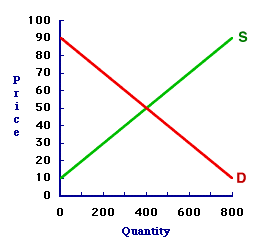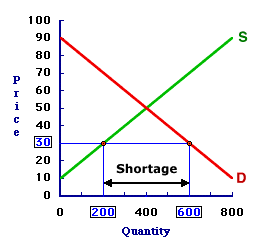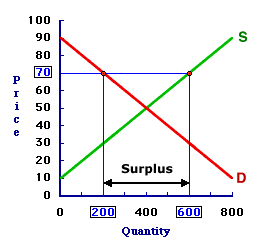
|
|
EFFICIENT SEARCH, DETERMINANTS: Two factors that affect information search are (1) the amount of purchase and (2) frequency of purchase. Goods that are relatively expensive increase the potential benefit of search. For example, saving 10 percent on the purchase price of a house is significantly more than saving 10 percent on the price of bar of soap. Buyers are thus likely to undertake extensive search when buying a house, but not for soap. Goods that are purchased more frequently also don't require extensive search activities. Since buyers already know the "best places" to buy the "highest quality" products at the "lowest prices" for frequently purchased goods, little can be gained from search.
Visit the GLOSS*arama
|
|


|

|
                           SELF CORRECTION, MARKET: The automatic process in which markets adjust from disequilibrium to equilibrium. With this self-correction process, the market price either increases or decreases in response to a shortage or a surplus to restore the balance between quantity demanded and quantity supplied. This process works automatically to achieve equilibrium without the need for outside intervention, such as government regulation. The self-correction process is an intrinsic aspect of voluntary market exchanges. Buyers seeking to pay the lowest price possible and sellers seeking to receive the highest price possible act to achieve and maintain equilibrium. If a market has a shortage, buyers are forced to bid the price higher, which eliminates the shortage and restores equilibrium. If a market has a surplus, sellers are forced to bid the price lower, which eliminates the surplus and also restores equilibrium.In and Out of BalanceTo see how the self-correction process of the market works, first consider three alternative prices--equilibrium price, low price, and high price. The equilibrium price, as the term suggests, generates equilibrium. The low price creates and shortage and the high price leads to a surplus.| Three Alternatives |  | Eliminating a Shortage |  | Eliminating a Surplus |  |
The market for 8-track tapes displayed in this exhibit can be used to illustrate these three alternatives. This graph was generated after long hours attending the 88th Annual Trackmania 8-Track Tape Collectors Convention at the Shady Valley Exposition Center. - Equilibrium Price: First up is the price that achieves equilibrium. This is the ultimate goal of the self-correction process. Click the [Equilibrium Price] button to highlight this condition of the market. The equilibrium price is 50 cents and the equilibrium quantity is 400 tapes. Once achieved, this equilibrium persists until disrupted by an external force.
- Low Price: A price below the equilibrium price causes a market shortage. Click the [Low Price] button to highlight this condition. At a price of 30 cents, the shortage is 400 tapes, the difference between a quantity demanded of 600 tapes and a quantity supplied of 200 tapes. This imbalance triggers the self-correction process with a price increase.
- High Price: A price above the equilibrium price causes a market surplus. Click the [High Price] button to highlight this condition. At a price of 70 cents, the surplus is 400 tapes, the difference between a quantity supplied of 600 tapes and a quantity demanded of 200 tapes. This imbalance also triggers the self-correction process, but with a price decrease.
Low Price and ShortageOne disequilibrium condition that activates the self-correction process is a shortage caused by a price below the equilibrium. The shortage created by a 30-cent price for the 8-track tape market is reproduced in this exhibit. The quantity demanded is greater than the quantity supplied. Self-correction comes to the rescue for this imbalance. With a market shortage, buyers are not able to buy all of the good that they seek to buy. As such, they force the price up. Click the [Price Rise] button to illustrate what occurs when they do. This higher price operates on both demand and supply to eliminate the shortage. On the supply side, the higher price enacts the law of supply to trigger an increase in the quantity supplied. On the demand side, the law of demand comes into play as the price increase induces a decrease in the quantity demanded. Both quantity changes work to eliminate the shortage. The quantity demanded was too much, but the price increase causes it to decrease. The quantity supplied was too little, but the price increase causes it to increase. Eventually the price rises enough, the quantity demanded decreases enough, and the quantity supplied increases enough to eliminate the shortage and restore equilibrium. High Price and SurplusThe other disequilibrium condition that activates the self-correction process is a surplus caused by a price above the equilibrium. The surplus created by a 70-cent price for the 8-track tape market is reproduced in this exhibit. The quantity demanded is less than the quantity supplied. Self-correction also comes into play for this imbalance. With a market surplus, sellers are not able to sell all of the good that they seek to sell. As such, they force the price down. Click the [Price Fall] button to illustrate what occurs when they do. This lower price also operates on both demand and supply to eliminate the surplus. On the supply side, the lower price works the law of supply to trigger a decrease in the quantity supplied. On the demand side, the law of demand guides buyers as the price decrease induces an increase in the quantity demanded. Both quantity changes work to eliminate the surplus. The quantity demanded was too little, but the price decrease causes it to increase. The quantity supplied was too much, but the price decrease causes it to decrease. Eventually the price falls enough, the quantity demanded increases enough, and the quantity supplied decreases enough to eliminate the surplus and restore equilibrium. An Automatic ProcessBest of all this self-correction process is automatic. The surplus and shortage are eliminating automatically by price changes. It is almost as through the process is guided by an invisible hand. No government controls, regulations, or laws are need. The market relies on nothing more than buyers seeking to purchase the good at the lowest possible price and sellers seeking to sell the good at the highest possible price.

Recommended Citation:SELF CORRECTION, MARKET, AmosWEB Encyclonomic WEB*pedia, http://www.AmosWEB.com, AmosWEB LLC, 2000-2025. [Accessed: July 5, 2025].
Check Out These Related Terms... | | | | | | | | | | | |
Or For A Little Background... | | | | | | |
And For Further Study... | | | | | |
Search Again?
Back to the WEB*pedia
|



|

|
WHITE GULLIBON
[What's This?]
Today, you are likely to spend a great deal of time strolling through a department store looking to buy either a replacement nozzle for your shower or a decorative windchime with plastic . Be on the lookout for infected paper cuts.
Your Complete Scope
This isn't me! What am I?
|

|
|
In the early 1900s around 300 automobile companies operated in the United States.
|

|
|
"Plans are only good intentions unless they immediately degenerate into hard work." -- Peter Drucker, management consultant
|

|
AACT
American Assocation of Commodity Traders
|

|
|
Tell us what you think about AmosWEB. Like what you see? Have suggestions for improvements? Let us know. Click the User Feedback link.
User Feedback
|


|


